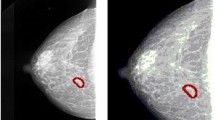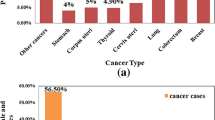Abstract
The objective of this paper is to demonstrate the utility of artificial neural networks, in combination with wavelet transforms for the detection of mammogram masses as malign or benign. A total of 45 patients who had breast masses in their mammography were enrolled in the study. The neural network was trained on the wavelet based feature vectors extracted from the mammogram masses for both benign and malign data. Therefore, in this study, Multilayer ANN was trained with the Backpropagation, Conjugate Gradient and Levenberg–Marquardt algorithms and ten-fold cross validation procedure was used. A satisfying sensitivity percentage of 89.2% was achieved with Levenberg–Marquardt algorithm. Since, this algorithm combines the best features of the Gauss–Newton technique and the other steepest-descent algorithms and thus it reaches desired results very fast.




Similar content being viewed by others
References
Murat, A., Arslan, A., and Ogur, E., The value of color duplex sonography in the discrimination of benign and malign breast masses. Firat Medical Journal. 10:68–71, 2005.
Özekes, S., Osman, O., and Çamurcu, Y., Computerized detection of architectural distortions in digital mammograms, The 19th International Conference on Computer Assisted Radiology and Surgery, Berlin, Germany, 2005.
Osman, O., and Göker, I., Detection of malignant tumors based on harmonic analysis, 13th Balkan Biochemical Biophysical Days & Meeting on Metabolic Disorders, Kusadasi, Turkey, 2003.
Basheer, I. A., and Hajmeer, M., Artificial neural networks: fundamentals, computing, design and applications. J. Microbiol. Meth. 43:3–31, 2000.
Chaudhuri, B. B., and Bhattacharya, U., Efficient training and improved performance of multilayer perceptron in pattern classification. Neurocomputing. 34:11–27, 2000.
Übeyli, E. D., and Güler, I., Multilayer perceptron neural networks to compute quasistatic parameters of asymmetric coplanar waveguides. Neurocomputing. 62:349–365, 2004.
Sakka, E., Prentza, A., Lamprinos, I., and Koutsouris, D., Microcalcification detection using multiresolution analysis based on wavelet transform, The International Special Topic Conference on Information Technology in Biomedicine, ITAB 2006, Ioannia, Greece, 2006.
Sandeep, C., Patnaik, L. M., and Jagannathan, N. R., Classification of magnetic resonance brain images using wavelets as input to support vector machine and neural network. Biomedical Signal Processing and Control. 1:86–92, 2006.
Misiti, M., Misiti, Y., Oppenheim, G., and Poggi, J. M., Wavelet toolbox user’s guide. Mathworks, Massachusetts, 1996.
Juarez, L. C., Volodymyr, P., and Sanchez, R. J. L., Detection of microcalcifications in digital mammograms images using wavelet transform. Proceedings of the Electronics, Robotics and Automotive Mechanics Conference. 2:58–61, 2006.
Ferreira, C. B. R., and Borges, D. L., Analysis of mammogram classification using a wavelet transforms decomposition. Pattern Recogn. Lett. 24:973–982, 2003.
Daubechies, I., Ten lectures on wavelets, CBMS Conference Lecture Notes 61. SIAM. Philadelphia, 1992.
Haykin, S., Neural networks: a comprehensive foundation. Prentice Hall, New York, 1999.
Lisboa, P. J. G., A review of evidence of health benefits from artificial neural networks in medical intervention. Neural Netw. 15:11–39, 2002.
Rumelhart, D. E., Hinton, G. E., and Williams, R. J., Learning representations by back-propagating errors. Nature. 323:533–536, 1986.
Verma, B., McLeod, P., and Klevansky, A., A novel soft cluster neural network for the classification of suspicious areas in digital mammograms. Pattern Recogn. 42 (9)1845–1852, 2009.
Schaefer, G., Nakashima, T., Zavisek, M., Yokota, Y., Drastich, A., and Ishibuchi, H., Breast Cancer classification using statistical features and fuzzy classification of thermograms. IEEE International Fuzzy Systems Conference, July 2007, Londra, England.
Razavi, A. R., Gill, H., Ahlfeldt, H., and Shahsavar, N., Predicting metastasis in breast cancer: comparing a decision tree with domain experts. J. Med. Syst. 31 (4)263–273, 2007.
Author information
Authors and Affiliations
Corresponding author
Rights and permissions
About this article
Cite this article
Kilic, N., Gorgel, P., Ucan, O.N. et al. Mammographic Mass Detection using Wavelets as Input to Neural Networks. J Med Syst 34, 1083–1088 (2010). https://doi.org/10.1007/s10916-009-9326-1
Received:
Accepted:
Published:
Issue Date:
DOI: https://doi.org/10.1007/s10916-009-9326-1




